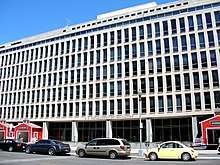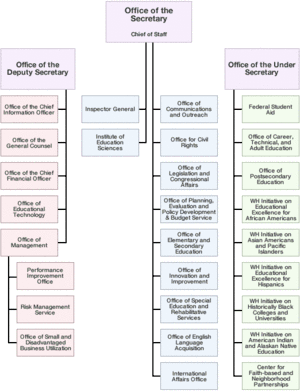United States Department of Education
The United States Department of Education (ED or DoED), also referred to as the ED for (the) Education Department, is a Cabinet-level department of the United States government. It began operating on May 4, 1980, having been created after the Department of Health, Education, and Welfare was split into the Department of Education and the Department of Health and Human Services by the Department of Education Organization Act, which President Jimmy Carter signed into law on October 17, 1979.[3][4]
 Seal of the U.S. Department of Education | |
 Flag of the U.S. Department of Education | |
 Lyndon Baines Johnson Department of Education Building, Department Headquarters | |
| Department overview | |
|---|---|
| Formed | October 17, 1979 |
| Preceding agencies |
|
| Jurisdiction | Federal government of the United States |
| Headquarters | Lyndon Baines Johnson Department of Education Building, 400 Maryland Avenue, Southwest, Washington, D.C., U.S. 20202 |
| Employees | 3912 (2018)[1] |
| Annual budget | $68 billion (2016)[2] |
| Department executives | |
| Key document | |
| Website | ed |
The Department of Education is administered by the United States secretary of education. It has under 4,000 employees (2018)[1] and an annual budget of $68 billion (2016).[2] The 2019 Budget also supports $129.8 billion in new postsecondary grants, loans, and work-study assistance to help an estimated 11.5 million students and their families pay for college.[5] Its official abbreviation is "ED" ("DOE" refers to the United States Department of Energy) and is also often abbreviated informally as "DoEd".
Functions
The primary functions of the Department of Education are to "establish policy for, administer and coordinate most federal assistance to education, collect data on US schools, and to enforce federal educational laws regarding privacy and civil rights."[6] The Department of Education does not establish schools or colleges.[7]
Unlike the systems of most other countries, education in the United States is highly decentralized, and the federal government and Department of Education are not heavily involved in determining curricula or educational standards (with the exception of the No Child Left Behind Act). This has been left to state and local school districts. The quality of educational institutions and their degrees is maintained through an informal private process known as accreditation, over which the Department of Education has no direct public jurisdictional control.
The Department of Education is a member of the United States Interagency Council on Homelessness,[8] and works with federal partners to ensure proper education for homeless and runaway youth in the United States.
Opposition to the Department of Education mainly stems from conservatives, who see the department as an undermining of states rights, and libertarians who believe it results in a state-imposed leveling towards the bottom and low value for taxpayers' money.[9]
Budget
The U.S. Department of Education oversees the nation's education system. The department sets uniform rules and standards which are applied nationwide. “Since the Department of Education (Education) began operations in fiscal year 1980, its mission has included promoting student achievement and ensuring equal access to educational opportunity. To do so, Education partners with state and local governments, which provide most of the resources to school districts for K-12 programs".[10]
|
| Budget of the Department of Education for FY 2015, showing its largest components[11] |
| Education in the United States |
|---|
|
|
|
For 2006, the ED discretionary budget was $56 billion and the mandatory budget contained $23 billion.[12] In 2009 it received additional ARRA funding of $102 billion.[13] As of 2011, the discretionary budget is $70 billion.[12]
History
Establishment
The Department's origin goes back to 1867, when President Andrew Johnson signed legislation creating the first Department of Education. Its main purpose was to collect information and statistics about the nation's schools. However, due to concern that the Department would exercise too much control over local schools, the new Department was demoted to an Office of Education in 1868.[14][15]
Over the years, the office remained relatively small, operating under different titles and housed in various agencies, including the United States Department of the Interior and the former United States Department of Health Education and Welfare (DHEW) (now the United States Department of Health and Human Services (DHHS)).[15] An unsuccessful attempt at creating a Department of Education, headed by a Secretary of Education, came with the Smith–Towner Bill in 1920.[16]
In 1939, the organization (then a bureau) was transferred to the Federal Security Agency, where it was renamed as the Office of Education. After World War II, President Dwight D. Eisenhower promulgated "Reorganization Plan No. 1 of 1953." The Federal Security Agency was abolished and most of its functions were transferred to the newly formed DHEW.[17]
In 1979, President Carter advocated for creating a cabinet-level Department of Education.[18] Carter's plan was to transfer most of the Department of Health, Education, and Welfare's education-related functions to the Department of Education.[18] Carter also planned to transfer the education-related functions of the departments of Defense, Justice, Housing and Urban Development, and Agriculture, as well as a few other federal entities.[18] Among the federal education-related programs that were not proposed to be transferred were Headstart, the Department of Agriculture's school lunch and nutrition programs, the Department of the Interior's Native Americans' education programs, and the Department of Labor's education and training programs.[18]
Upgrading Education to cabinet level status in 1979 was opposed by many in the Republican Party, who saw the department as unconstitutional, arguing that the Constitution doesn't mention education, and deemed it an unnecessary and illegal federal bureaucratic intrusion into local affairs. However, many see the department as constitutional under the Commerce Clause, and that the funding role of the department is constitutional under the Taxing and Spending Clause. The National Education Association supported the bill, while the American Federation of Teachers opposed it.[19]
As of 1979, the Office of Education had 3,000 employees and an annual budget of $12 billion.[20] Congress appropriated to the Department of Education an annual budget of $14 billion and 17,000 employees when establishing the Department of Education.[21] During the 1980 presidential campaign, Gov. Reagan called for the total elimination of the U.S. Department of Education, severe curtailment of bilingual education, and massive cutbacks in the federal role in education. Once in office, President Reagan significantly reduced its budget.[22]
Early history
The Republican Party platform of 1980 called for the elimination of the Department of Education created under Carter and President Ronald Reagan promised during the 1980 presidential election to eliminate it as a cabinet post,[23] but he was not able to do so with a Democratic House of Representatives.[24] In the 1982 State of the Union Address, he pledged: "The budget plan I submit to you on Feb. 8 will realize major savings by dismantling the Department of Education."[24]
By 1984 the GOP had dropped the call for elimination from its platform, and with the election of President George H. W. Bush in 1988, the Republican position evolved in almost lockstep with that of the Democrats, with Goals 2000 a virtual joint effort.
After the Newt Gingrich-led "revolution" in 1994 had taken control of both Houses of Congress, federal control of and spending on education soared. That trend continued unabated despite the fact that the Republican Party made abolition of the department a cornerstone of 1996 platform and campaign promises, calling it an inappropriate federal intrusion into local, state, and family affairs.[24] The GOP platform read: "The Federal government has no constitutional authority to be involved in school curricula or to control jobs in the market place. This is why we will abolish the Department of Education, end federal meddling in our schools, and promote family choice at all levels of learning."[24]
In 2000, the Republican Liberty Caucus passed a resolution to abolish the Department of Education.[25] Abolition of the organization was not pursued under the George W. Bush administration, which made reform of federal education a key priority of the president's first term. In 2008 and 2012, presidential candidate Ron Paul campaigned in part on an opposition to the department.[26]
Later history

Under President George W. Bush, the department primarily focused on elementary and secondary education, expanding its reach through the No Child Left Behind Act. The department's budget increased by $14 billion between 2002 and 2004, from $46 billion to $60 billion.[24][28]
On March 23, 2007, President George W. Bush signed into law H.R. 584, which designates the ED Headquarters building as the Lyndon Baines Johnson Department of Education Building.[29]
In the time after George W. Bush's presidency and towards the end of President Barack Obama's presidency, there was an extremely noticeable problem within the education system that was excluding many children from receiving the striving opportunities that they should have been given throughout their schooling careers. So, In December 2015 President Barack Obama had instituted the Every Student Succeeds Act, which reauthorized the Elementary Secondary Education Act. “In December 2015, the Every Student Succeeds Act (ESSA) was signed into law, reauthorizing the Elementary and Secondary Education Act (ESEA) and replacing the No Child Left Behind Act (NCLB). ESEA, the federal law that authorizes federal funding for K-12 schools, represents the nation’s commitment to equal educational opportunity for all students and has influenced the education of millions of children."
Organization

| Program | |
|---|---|
| Secretary of Education | Office of Communications and Outreach |
| Office of the General Counsel | |
| Office of Inspector General | |
| Office of Legislation and Congressional Affairs | |
| Office for Civil Rights | |
| Office of Educational Technology | |
| Institute of Education Sciences *National Center for Education Statistics **National Assessment of Educational Progress **Education Resources Information Center | |
| Office of Innovation and Improvement | |
| Office of the Chief Financial Officer | |
| Office of Management | |
| Office of the Chief Information Officer | |
| Office of Planning, Evaluation and Policy Development *Budget Service | |
| Risk Management Service | |
| Deputy Secretary of Education | Office of Elementary and Secondary Education *Education Facilities Clearinghouse *Office of Migrant Education *Office of Safe and Healthy Students *Student Achievement and School Accountability Programs *White House Initiative on Asian Americans and Pacific Islanders *White House Initiative on Educational Excellence for Hispanics *White House Initiative on American Indian and Alaska Native Education *White House Initiative on Educational Excellence for African Americans |
| Office of English Language Acquisition | |
| Office of Special Education and Rehabilitative Services *National Institute on Disability and Rehabilitation Research *Office of Special Education Programs *Rehabilitation Services Administration | |
| Office of Innovation and Improvement | |
| Under Secretary of Education | Office of Postsecondary Education |
| Office of Career, Technical, and Adult Education | |
| Office of Federal Student Aid | |
| President's Advisory Board on Tribal Colleges and Universities | |
| President's Advisory Board on Historically Black Colleges and Universities | |
| Associated federal organizations | Advisory Councils and Committees |
| National Assessment Governing Board (NAGB) | |
| National Advisory Council on Indian Education | |
| Federal Interagency Committee on Education | |
| Advisory Commission on Accessible Instructional Materials in Postsecondary Education for Students with Disabilities | |
| National Board for Education Sciences | |
| National Board of the Fund for the Improvement of Postsecondary Education | |
| Federally aided organizations | Gallaudet University |
| Howard University | |
| National Technical Institute for the Deaf | |
See also
- Council for Higher Education Accreditation
- Educational attainment in the United States
- Free Application for Federal Student Aid
- FICE code
- Federal Student Aid
- National Diffusion Network
- School Improvement Grant
- Title 34 of the Code of Federal Regulations
Related legislation
- 1965: Elementary and Secondary Education Act (ESEA)
- 1965: Higher Education Act of 1965 (HEA) (Pub. L. No. 89-329)
- 1974: Family Educational Rights and Privacy Act (FERPA)
- 1974: Equal Educational Opportunities Act of 1974 (EEOA)
- 1975: Education for All Handicapped Children Act (EHA) (Pub. L. No. 94-142)
- 1978: Protection of Pupil Rights Amendment
- 1980: Department of Education Organization Act (Pub. L. No. 96-88)
- 1984: Equal Access Act
- 1990: The Jeanne Clery Disclosure of Campus Security Policy and Campus Crime Statistics Act (Clery Act)
- 1994: Improving America's Schools Act of 1994
- 2001: No Child Left Behind Act (NCLB)
- 2004: Individuals with Disabilities Education Act (IDEA)
- 2005: Higher Education Reconciliation Act of 2005 (HERA) (Pub. L. No. 109-171)
- 2006: Carl D. Perkins Career and Technical Education Improvement Act
- 2007: America COMPETES Act
- 2008: Higher Education Opportunity Act (HEOA) (Pub. L. No. 110-315)
- 2009: Race to the Top
- 2009: Student Aid and Fiscal Responsibility Act
- 2010: Health Care and Education Reconciliation Act of 2010
- 2015: Every Student Succeeds Act (ESSA)
References
- Stratford, Michael (22 January 2018). "Education Department goes into shutdown mode". Politico. Archived from the original on 25 January 2018. Retrieved 25 January 2018.
- "Overview and Mission Statement - U.S. Department of Education". www2.ed.gov. Archived from the original on 31 August 2017. Retrieved 3 September 2016.
- Pub.L. 96–88, S. 210, 93 Stat. 668, enacted October 17, 1979
- "Department of Education Organization Act, 1979". wordpress.com. 15 April 2011. Archived from the original on 7 January 2018. Retrieved 15 April 2011.
- U.S. Secretary of Education (14 February 2018). "ED FY2019 Budget" (PDF). ed.gov. Archived (PDF) from the original on 18 November 2018. Retrieved 2 November 2018.
- What We Do Archived 6 January 2011 at the Wayback Machine. ED.gov. Retrieved on 2013-07-17.
- "An Overview of the U.S. Department of Education, p. 2". United States Department of Education. Archived from the original on 30 December 2010. Retrieved 25 August 2012.
- "Department of Education | Member Agency | United States Interagency Council on Homelessness (USICH)". Usich.gov. Archived from the original on 26 August 2012. Retrieved 25 August 2012.
- "Laissez-faire-learning". 25 June 2012. Archived from the original on 11 October 2014. Retrieved 28 June 2012.
- Hubbard, Janie; Swain, Holly Hilboldt (July 2017). "Using the U.S. Civil Rights Movement to explore social justice education with K-6 pre-service teachers". The Journal of Social Studies Research. 41 (3): 217–233. doi:10.1016/j.jssr.2016.09.002. ISSN 0885-985X.
- "ED History" (PDF). U.S. Department of Education. 25 September 2015. Archived (PDF) from the original on 21 February 2017. Retrieved 28 February 2017.
- "Overview". U.S. Department of Education Budget Office. 12 February 2011. Archived from the original on 4 September 2010. Retrieved 27 March 2011.
- "Wayback Machine" (PDF). 13 January 2017. Archived from the original (PDF) on 13 January 2017.
- (1) "Act to Establish a Federal Department of Education, 1867". wordpress.com. 19 February 2011. Archived from the original on 18 July 2011. Retrieved 15 April 2011.
(2) Chap. CLVIII. 14 Stat. 434 Archived 21 December 2016 at the Wayback Machine from "A Century of Lawmaking for a New Nation: U. S. Congressional Documents and Debates, 1774–1875" Archived 6 April 2012 at the Wayback Machine. Library of Congress, Law Library of Congress. Retrieved April 25, 2012. - "The Department's History". An Overview of the U.S. Department of Education. Washington, D.C.: United States Department of Education. September 2010. p. 1. Archived from the original on 31 March 2020. Retrieved 11 April 2020.
- "The Smith-Towner Bill". Elementary School Journal. 20 (8): 575–583. April 1920. doi:10.1086/454812. JSTOR 994235.
- "Oral History Interview with Oscar R. Ewing." Archived 21 August 2016 at the Wayback Machine Oral History Interviews. Truman Presidential Library. May 1, 1969; Reorganization Plan No. 1 of 1953. Title 5: Appendix: Reorganization Plans. Archived 12 May 2009 at the Wayback Machine Transmitted to the U.S. Senate and U.S. House of Representatives, March 12, 1953.
- "Department of Education Outlined". Associated Press. 9 February 1979. Archived from the original on 7 March 2016. Retrieved 23 October 2015.
- "House Narrowly Passes Department of Education Bill". Spokane, Washington. The New York Times. 12 July 1979. Archived from the original on 13 May 2016. Retrieved 23 October 2015.
- Hechinger, Fred M (3 September 1979). "Federal Education Branch Is Foundering, Leaderless". Lexington, North Carolina. New York Times News Service. Archived from the original on 7 March 2016. Retrieved 23 October 2015.
- "Education Department Created". United Press International. 18 October 1979.
- Educational Horizons: "The Educational Legacy of Ronald Reagan" Archived 2 April 2015 at the Wayback Machine, Summer 2004 v. 82 n. 4 p. 256
- "Online Backgrounders: The Department of Education". PBS. Fall 1996. Archived from the original on 7 November 2013. Retrieved 26 July 2005.
- Veronique de Rugy and Marie Gryphon (11 February 2004). "Elimination Lost: What happened to abolishing the Department of Education?". Cato Institute. Archived from the original on 7 December 2013. Retrieved 15 February 2017.
This article originally appeared in National Review Online on February 11, 2004.
- "Education". 2007. Archived from the original on 17 November 2007. Retrieved 14 September 2007.
- Stossel, John (10 December 2007). "Ron Paul Unplugged". ABC News. Archived from the original on 9 December 2008. Retrieved 30 January 2008.
- "Paige Fields Team to Leave No Child Behind". United States Department of Education. 11 April 2002. Archived from the original on 24 September 2003.
- Young, Michelle D.; Winn, Kathleen M.; Reedy, Marcy A. (13 October 2017). "The Every Student Succeeds Act: Strengthening the Focus on Educational Leadership". Educational Administration Quarterly. 53 (5): 705–726. doi:10.1177/0013161x17735871. ISSN 0013-161X.
- "President Bush Signs H.R. 584, Designates U.S. Department of Education as the Lyndon Baines Johnson Federal Building". Georgewbush-whitehouse.archives.gov. 23 March 2007. Archived from the original on 21 July 2011. Retrieved 25 August 2012.
Further reading
- Radin, Beryl A., and Willis D. Hawley (1988). Politics of Federal Reorganization: Creating the U.S. Department of Education, ISBN 978-0080339771
- Heffernan, Robert V. (2001). Cabinetmakers: Story of the Three-Year Battle to Establish the U.S. Department of Education, ISBN 978-0595158706
External links
| Wikimedia Commons has media related to United States Department of Education. |
- Official website

- Department of Education on USAspending.gov
- Department of Education in the Federal Register
- ERIC Digests – Informational digests on educational topics produced by the U.S. Department of Education before 1983.
- Works by United States Department of Education at Project Gutenberg
- Works by or about United States Department of Education at Internet Archive
- United States Government Manual, Department of Education
